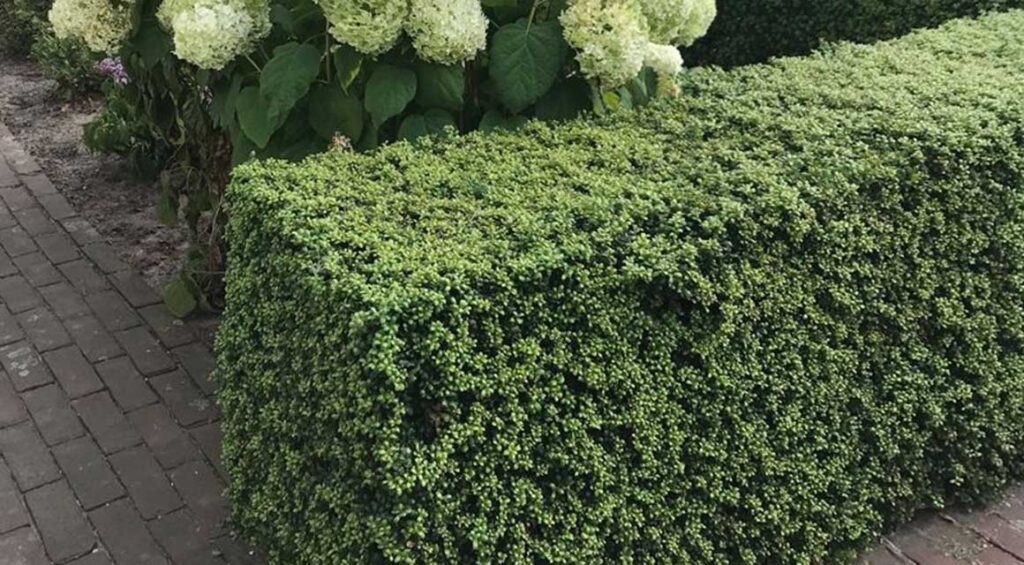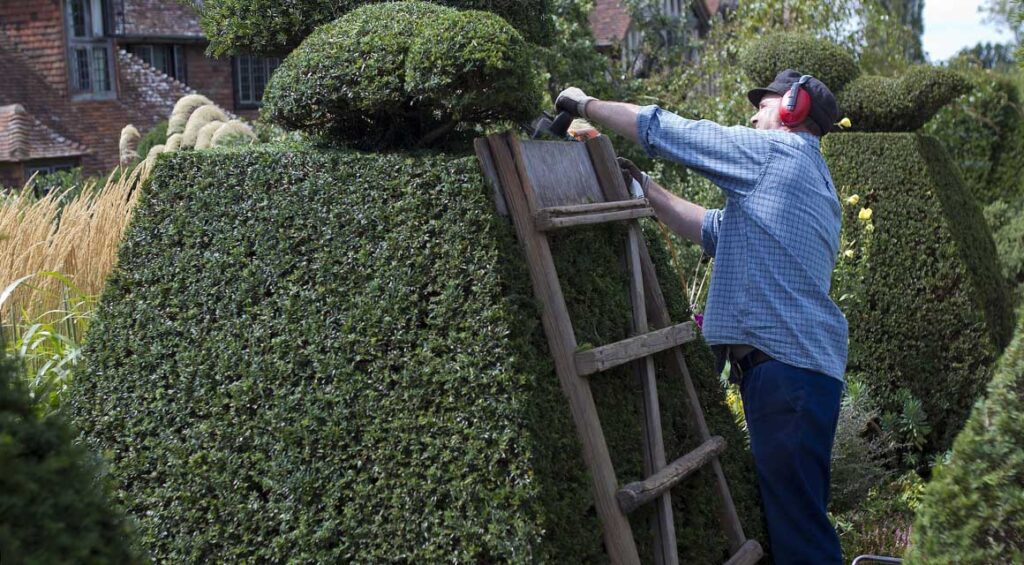A hedge can have different shapes. Nevertheless, the idea that most people have of a hedge is a formal, dense hedge that marks the border of your garden like a kind of green wall. Therefore, many gardeners also ask us: how do I get a dense hedge? We are happy to give you some tips on this, from choosing hedge plants to maintaining your hedge so that it keeps its dense shape.

Contents
The right hedge plants for a dense hedge
A dense hedge starts with choosing the right hedge plants. If you want a hedge that is nice and dense and green all year round, it is best to choose evergreen hedge plants. There are deciduous hedge plants that can be pruned into a dense shape, but then you will be looking at a bare hedge in the winter. With a hedge of conifers or another evergreen hedge, your garden fence will be green and handsome all year round. Small leaves also contribute to how dense a hedge becomes. A small leaf is the least likely to interfere with the straight shape of a hedge and, in this case, is easier to trim away.
If the height of the hedge is not an issue, we recommend slow-growing hedge plants. Hedge plant species, such as yew and boxwood, grow only 10 to 20 inches per year and therefore require less pruning to maintain their shape. Boxwood hedges do not grow tall and are often seen in castle or palace parks. However, boxwood disease and boxwood fungus have recently been discovered in Europe and can be devastating to your boxwood hedge. Fortunately, there are many beautiful boxwood replacement plants, of which Japanese holly (Ilex crenata) is the best slow-growing option.
Of course, those seeking privacy will need a hedge that cannot be overlooked. For a higher dense hedge, many fast-growing conifers are suitable. In this case, take into account that you should trim your hedge more frequently than you may be used to. This is especially important with cypresses, such as the leylandii (Cupressocyparis leylandii) and the false cypress (Chamaecyparis lawsoniana). These do not grow new leaves on their old wood and therefore need to be cut back regularly to avoid bare spots. Yews can also grow into privacy hedges, but they need longer to do so.

How can pruning contribute to a compact hedge shape?
Do your hedge plants meet all the requirements for a dense hedge and is the soil in your garden suitable for these plants? Then you can plant your hedge and actually begin the most important part of your hedge: maintenance. There are no plants that naturally grow in a straight block shape, so some pruning is always required to ensure your hedge maintains its dense form. Exactly how often and when you need to trim your hedge varies by plant species, though the ideal pruning time for most hedge plants is between March and September. Outside of these months, they are in hibernation.
For a slow-growing hedge plant species, such as boxwood, it’s quite tempting to trim just once within this period. And admittedly: A boxwood hedge or a yew hedge will look quite shapely if you trim it every year. However, most garden owners choose to trim these hedge plants twice a year to keep them looking nice and tight. The first of the two prunings should be done before the longest day of the year. Cut your hedge a little wider at the bottom than at the top. This may seem contradictory if you want a dense hedge, but this will ensure that every part of the hedge gets an equal amount of light.
Fast growing hedge plants logically require more than two cuts per year. In one year, for example, the Leylandii grows up to three feet, which can quickly require four prunings in that time period. This is not only because it will not continue to grow on old wood. Its rapid growth also means that it quickly loses its shape. Fortunately, conifers are generally fairly easy to prune back. Pruning for these hedge plants is also done between March and September. Try to keep the periods between pruning about the same.

Buy a dense prefabricated hedge
Are you not that handy with pruning shears, or do you just want your hedge to look the way you want it to immediately after planting? Then you could start with a prefabricated hedge.
Don’t forget to trim back your prefab hedge after planting. Immediately after planting, your hedge will look beautiful, but it will continue to grow in your garden soil, so it will need regular pruning to stay beautiful. For this, you can follow the same instructions as when you start with young hedge plants that will continue to grow in your garden.
Our web store has a wide selection of different hedge plants. If you are looking for a less formal hedge, such as a laurel hedge or a privet hedge, you are also welcome to contact us. We also have a large selection of flowering hedge plants.

